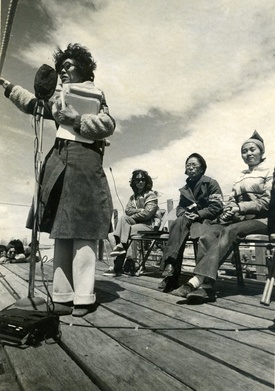Like so many events these days, the 51st annual Manzanar Pilgrimage was cancelled on Thursday, April 17 due to COVID-19. For the first time, the Manzanar Pilgrimage, a tradition that brings former incarcerees, activists, and scholars together, will not be held on the grounds of the Manzanar Concentration Camp. The pilgrimage’s organizing group, the Manzanar Committee, announced in its press brief that while the decision was difficult, “the health and well-being of our community, particularly our elders, is most important, and cancelling is in everyone’s best interests.”
For Bruce Embrey, the co-chair of the Manzanar Committee, the move to cancel the pilgrimage was difficult for a number of reasons. The son of activist and Manzanar survivor Sue Kunitomi Embrey, Bruce Embrey’s work has been instrumental in continuing the pilgrimage tradition and advocating for the site’s recognition by the National Parks Service. In an interview for NikkeiWest, Embrey stated that the decision not to host the pilgrimage at the site this year was extremely difficult, and serves as an opportunity to reflect on why the pilgrimage was founded.
Embrey understands the importance of the site personally; when his mother returned to the camp for the first time, he remembers his father telling him she said “stop” before they crossed the cattle guard onto the site. After gathering her thoughts, she decided she was ready to return. That story, for Embrey, illustrates “how even after decades, the idea of re-entering an old confinement site created tension and conflict. Obviously my mother simply hesitated but many survivors never returned, openly saying they would never return to the site of their oppression and suffering.”

His mother would become an important organizer of the Manzanar Committee, attending the first pilgrimage to Manzanar in 1969. When Embrey later attended the pilgrimage for the first time, he described it as “an event that would not just rebuild the community, but serve as a safe place to share stories of life before, during, and after camp.” Before, Embrey said, there was never a way to collectively assess what happened in camp and why. And while the first meeting was held over twenty-four years after Manzanar’s closing, the story of camp was a part of the lives of most families. As Sue Kunitomi Embrey put it: “Resettlement has never ended.”
Beyond physically connecting with the space, the pilgrimage represented a political act of coming together and making sense of the events of the camp. At a time when advocates like Mike Masaoka and Bill Hosokawa supported unconditional patriotism - Hosokawa’s Nisei: The Quiet Americans was published the same year - returning to the camps meant confronting the past and seeing the criminality of the government’s decision to incarcerate Japanese Americans. This complimented the broader sentiments of 1969, a time which questioned the injustices of the Vietnam War and racism at home. For Embrey, this spirit of supporting those marginalized by the actions of the U.S. government represent an important part of the Manzanar Pilgrimage, and in recent years the pilgrimage has invited groups victimized by hate crimes such as Muslim Americans to participate in the ceremony.
Following this political tradition, there are several pressing matters that this year’s pilgrimage aims to address. The closing of detention camps run by the Trump Administration for immigrants and refugees - sometimes on the site of former WWII internment camps such as Fort Sill - is now the cause of Japanese American groups such as Tsuru for Solidarity, and is an issue to be addressed by this year's pilgrimage. As a member of Tsuru for Solidarity, Embrey sees the use of detention centers for refugees and the rise of anti-Asian hysteria drummed up by the White House as issues that underscore the need for the pilgrimage
Yet the rise of the COVID-19 pandemic across the United States is a hurdle for Japanese American organizers like Embrey. “It is very frustrating at a moment in our history that, more important than ever, that we cannot go back to Manzanar, Tule Lake, Rohwer, or Jerome because of COVID-19, because this story needs to be heard and remembered more than ever. I think the use of COVID-19 as a means to whip up anti-Asian discrimination is similar to that back in ’42, and calls out for our story to be told.”
This year’s pilgrimage, held in memory of community organizer Hank Umemoto, will instead be hosted online on April 25th, allowing for participants to interact virtually and hear speeches from the committee and Alan Nishio, the keynote speaker of this year’s pilgrimage. While nothing can truly replace the importance of connecting with the physical space of the Manzanar Camp site, Embrey noted it is better to continue in any way possible.
“That’s why we have to go online,” Embrey explained, “no matter what, we have to make sure this story isn’t silenced.”
*This article was originally published on NikkeiWest on April 25, 2020.
© 2020 Jonathan van Harmelen







